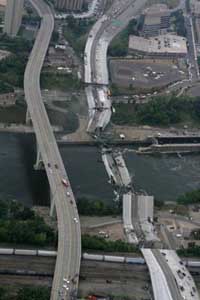Tens of thousands of U.S. bridges rated deficient
More than 70,000 bridges across America are rated structurally deficient like the span that collapsed in Minneapolis, and engineers estimate repairing them all would take at least a generation and cost more than $188 billion (EUR 137 billion).

That works out to at least $9.4 billion (EUR 6.9 billion) a year over 20 years, according to the American Society of Civil Engineers.
The bridges carry an average of more than 300 million vehicles a day.
It is unclear how many of the spans pose actual safety risks. Federal officials alerted the states late Thursday to immediately inspect all bridges similar to the Mississippi River span that collapsed.
There are 756 such steel-deck truss bridges, according to highway officials. No list of bridge locations was available.
In a separate cost estimate, the Federal Highway Administration has said addressing the backlog of needed bridge repairs would take at least $55 billion (EUR 40 billion). That was five years ago, with expectations of more deficiencies to come.
It is money that Congress, the federal government and the states have so far been unable or unwilling to spend.
"We're not doing what the engineers are saying we need to be doing," said Gregory Cohen, president of the American Highway Users Alliance, an advocacy group representing a wide range of motorists.
"Unfortunately when you consistently underinvest in roads and bridges ... this is the dangerous consequence," Cohen said of Wednesday's deadly Mississippi River bridge collapse in Minneapolis. He said engineers have estimated $75 billion (EUR 55 billion) a year is needed just to keep highways and bridges from further deterioration, but that only around $60 billion (EUR 44 billion) a year is being provided.
At least 73,533 of 607,363 bridges in America, or about 12 percent, were classified as "structurally deficient," including some built as recently as the early 1990s, according to 2006 statistics from the Federal Highway Administration.
The federal government provides 80 percent of the money for construction, repair and maintenance of the so-called federal-aid highway system including Interstate highways and bridges. But states set priorities and handle construction and maintenance contracts.
A bridge is typically judged structurally deficient if heavy trucks are banned from it or there are other weight restrictions, if it needs immediate work to stay open or if it is closed. In any case, such a bridge is considered in need of considerable maintenance, rehabilitation or even replacement.
Congressional leaders say the number of bridges in need of repair is too high and the funding too low.
There is crumbling infrastructure all over the country, said Democratic Senate Majority Leader Harry Reid. Sen. Patty Murray, the Democrat who heads the Senate panel that controls transportation spending, said the Bush administration has threatened vetoes when Democrats try to increase such spending.
White House deputy press secretary Scott Stanzel, accusing the Democrats of using the bridge collapse for partisan purposes, said Bush had increased funding for federal highways by about 30 percent during his administration. The president had threatened to veto legislation not over highway funding but because of billions of dollars in excess funding in other areas, Stanzel said.
Democrats were not alone in calling for more bridge funding.
"People think they're saving money by not investing in infrastructure, and the result is you have catastrophes like this," said Rep. Tom Petri, a Republican member of the House transportation committee.
The federal government is now providing about $40 billion (EUR 29.3 billion) a year to improve and expand the nation's highways and bridges.
The main source of revenue for roads and bridges, the federal highway trust fund, is failing to keep up with spending demand.
Funding is not the only issue getting attention after the Minnesota collapse.
Transportation Secretary Mary Peters said in an interview with The Associated Press that she had asked her department's inspector general to evaluate the agency's overall bridge inspections.
According to the Federal Highway Administration, most bridges in the U.S. Highway Bridge Inventory - 83 percent - are inspected every two years. About 12 percent, those in bad shape, are inspected annually, and 5 percent, those in very good shape, every four years.
The Department of Transportation's inspector general last year criticized the Highway Administration's oversight of interstate bridges. The March 2006 report said investigators found incorrect or outdated maximum weight calculations and weight limit postings in the National Bridge Inventory and in states' bridge databases and said the problems could pose safety hazards. The Highway Administration agreed that improvements in its oversight of state bridge inspections and data were needed.
Incorrect load ratings could endanger bridges by allowing heavier vehicles to cross than should, and could affect whether a bridge is properly identified as structurally deficient in the first place, the inspector general said.
Subscribe to Pravda.Ru Telegram channel, Facebook, RSS!


